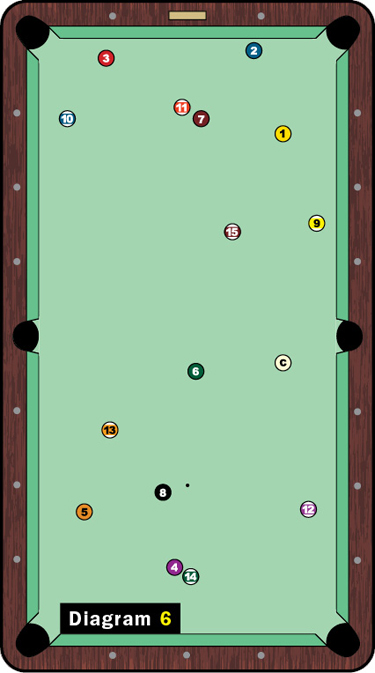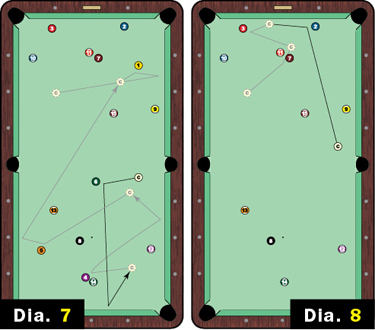|
|
Current Issue
Previous Page
Problems? What Problems?
Turn obstacles into speed bumps on the road to victory.
By "Mad Max" Eberle

 |
ON MY YouTube channel, I've got a number of videos where I run through a rack in a particular game and walk you through my thought process, from shot selection to position play to execution. Whether it's straight pool or 10-ball, this approach is one way for you to understand what it takes to play pool at a high level.
For our discussion here, let's take a look at the rack of 8-ball shown in Diagram 6. (You can watch me run this rack in the YouTube video, "Max Eberle 8-Ball Coaching No. 2.") Don't yet look at the smaller tables. Your opponent has just come up dry on the break and it's your shot. What do you do?
First, let's deal with the most important question you can ask yourself: Stripes or solids? You have fairly easy opening shots for both stripes and solids, so that's not a concern. In this situation, both choices present difficulties. The two clusters - the 7-11 and the 4-14 - should stand out. The main reason I like solids in this case is the arrangement of the 4 and 14 balls. The 4 ball is open for the bottom left corner pocket, while the 14 ball needs to be broken out, or requires you to play perfect position for a side or opposite corner pocket.
When you are formulating your plan to run a rack in 8-ball, dealing with difficult balls is everything. Sometimes you can't get to a problem early, but you should still plan exactly how you will solve it later. In this case, you have an angle on the 6 ball that allows you to play position on the 4 ball. Might as well deal with this obstacle early, right?
It's imperative that you stay "below" the 4 ball, meaning you can pocket it in the lower left without bumping into the 14. At the same time, if you are too short on the 4 ball and the 14 is in the way, you might be forced to play the 1 instead. Take a look at Diagram 7. You can see how I played shape on the 4, which then allowed me to draw off the long rail and into position for the 5.
Now that you've dealt with the 4 ball, turn your attention to the balls up-table. The 7 is definitely your biggest concern. You can go from the 5 to the 1 ball, which is in a perfect spot to let you get in position to play the 7 in the upper right corner. (See Diagram 8.)
At this point, it's just a matter of clearing the 2 and 3 to get back in line with the 8 ball for the win. Now, as far as your "key ball" - that is, the ball used to get shape on the 8 - in this situation, the 2 ball doesn't look like a normal key ball, but it's the best choice, considering your solutions for the 4 and 7 balls.
In review, the 1 is best served getting shape on the 7 and there's no practical way to get from the 3 to the 8. We're left with the 2, where you can get down-table between the 9 and 15 whether your above the object ball or along the short rail (or below) the 2, as shown.
It's important to remember that 8-ball allows for talented players to wing it from time to time and still get positive results. But when you're facing a player with equal talent and superior planning abilities, you've got about the same chances as a snowball on a bed of hot lava - at least in the long run.
If you want to improve your 8-ball skills, work on precise position play. This is what pool's all about, especially 8-ball. After that, try leaving yourself in areas where you may have more than one shot, incase something goes wrong. But when I'm at my best, I can name my pattern and execute it over and over again. Most players, even the really good ones, can't compete with that. Playing - and planning - at this level defeats champions and leads to 8-ball titles.
With national titles at the junior and collegiate levels and third-place finish at the 2006 World Straight-Pool Championship, Max Eberle is one of the West Coast's best instructors. Check www.maxeberle.com for more information.
Previous Page
Top |
|





